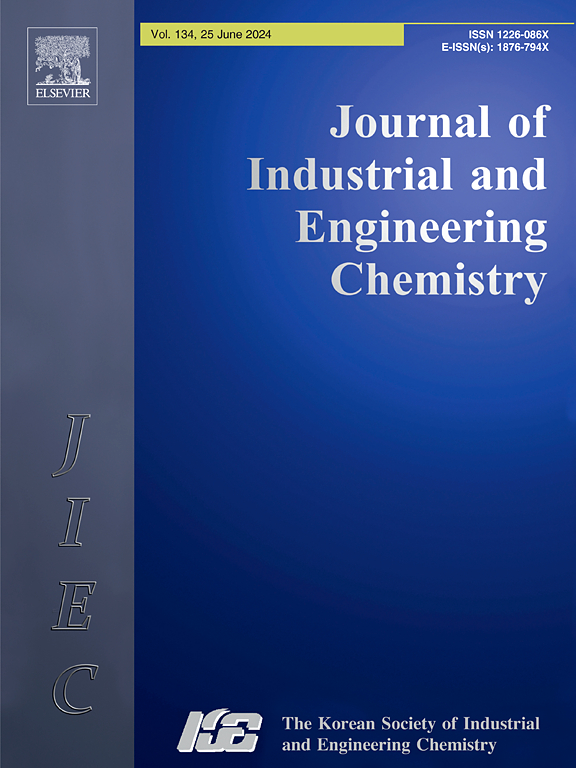采用碳化聚合物纳米流体提高采收率:二氧化碳利用和缓蚀剂的新方法
IF 5.9
3区 工程技术
Q1 CHEMISTRY, MULTIDISCIPLINARY
Journal of Industrial and Engineering Chemistry
Pub Date : 2025-02-20
DOI:10.1016/j.jiec.2025.02.040
引用次数: 0
摘要
人为碳排放已成为全球关注的问题,已经试验了若干缓解战略。利用二氧化碳来提高采收率有可能支持这一目标,近年来碳酸水注入越来越受欢迎。然而,作为注入二氧化碳的储层管道的金属管会产生严重的副作用,如诱导腐蚀,这就变得有害了。这项研究解决了这个问题,同时提出了一种碳酸水配方,可以提高采收率,同时减少二氧化碳的腐蚀作用。用聚丙烯酰胺(PAM)在氧化锌纳米粒子(ZnO NPs)的超声水分散体中制备了聚合物纳米流体(PNFs)。在0.01%、0.02%和0.03 wt%的浓度下,使用了两种不同的ZnO纳米粒子,一种是商业的(球形形态),另一种是自制的(花状形态),并对所得的纳米粒子(分别命名为PCZ和PDZ)进行了分析表征,并从CO2吸收率、流变性能、界面张力(IFT)降低能力、增量回收潜力等方面进行了比较。碳化条件下的缓蚀性能。结果发现,在0.01 wt%的浓度下引入ZnO NPs,使二氧化碳吸收率提高了8.3% (PCZ)和26.88% (PDZ),界面张力从40.54mN/m (0 wt%)降低到~ 14.67mN/m (PCZ)和~ 12.21mN/m (PDZ)。当ZnO NP浓度为0.03 wt%时,PCZ的腐蚀速率降低58.68%,而PDZ的腐蚀速率降低到70.67%。在岩心驱油测试中,碳化PDZ的产油量比PCZ高出12 - 20%。因此,如果定制聚合物分散体中的NPs,可以提高储层的采收率,同时携带更多的二氧化碳。此外,PDZ的优异性能证明了定义形态的重要性,这在NPs的选择中起着关键作用,因为花状形态提供了更多与CO2相互作用的位点。本文章由计算机程序翻译,如有差异,请以英文原文为准。

Enhanced Oil Recovery using Carbonated Polymeric Nanofluids: A New Age Approach to CO2 Utilization and Corrosion Mitigation
Anthropogenic carbon emissions have become a global concern and several mitigation strategies have been tested. The utilization of carbon dioxide for enhanced oil recovery has the potential to support this cause, and carbonated water injection has gained popularity in recent times. However, this becomes detrimental as the metallic tubular serving as the conduit to the oil reservoir for CO2 injection falls prey to severe side effects, such as induced corrosion. This study addresses this issue while suggesting a carbonated water formulation that can enhance oil recovery while reducing the corrosive effects of CO2. Polymeric nanofluids (PNFs) were prepared with Polyacrylamide (PAM) in well-sonicated aqueous dispersions of Zinc Oxide nanoparticles (ZnO NPs). Two variants of ZnO NPs, one commercial (spherical morphology) and another in-house synthesized (flower-like morphology), were used at concentrations of 0.01 %, 0.02 %, and 0.03 wt%, and the resulting PNFs (named PCZ and PDZ, respectively) were analytically characterized and compared for efficacy in terms of CO2 absorptivity, rheological behavior, interfacial tension (IFT) reducing ability, incremental recovery potential, and most importantly, corrosion inhibitory properties under carbonated conditions. It was discovered that the introduction of ZnO NPs at 0.01 wt% enhanced carbon dioxide absorption by 8.3 % (PCZ) and 26.88 % (PDZ), decreased interfacial tension from 40.54mN/m (0 wt%) to ∼14.67mN/m (PCZ) and ∼ 12.21mN/m (PDZ). At 0.03 wt% ZnO NP concentration, PCZ was able to reduce the corrosion rate by 58.68 %, and PDZ even performed better by reducing the rate to 70.67 %. In terms of incremental oil recovery through core flood tests, carbonated PDZ outperformed PCZ by 12–20 % of the original oil in place. Therefore, NPs in polymeric dispersions, if customized, can improve the oil recovery potential in the reservoir while carrying a higher amount of CO2. In addition, the superior performance of the PDZ attests to the significance of the defined morphology, which plays a key role in the selection of NPs, because the flower-like morphology provides more sites for interaction with CO2.
求助全文
通过发布文献求助,成功后即可免费获取论文全文。
去求助
来源期刊
CiteScore
10.40
自引率
6.60%
发文量
639
审稿时长
29 days
期刊介绍:
Journal of Industrial and Engineering Chemistry is published monthly in English by the Korean Society of Industrial and Engineering Chemistry. JIEC brings together multidisciplinary interests in one journal and is to disseminate information on all aspects of research and development in industrial and engineering chemistry. Contributions in the form of research articles, short communications, notes and reviews are considered for publication. The editors welcome original contributions that have not been and are not to be published elsewhere. Instruction to authors and a manuscript submissions form are printed at the end of each issue. Bulk reprints of individual articles can be ordered. This publication is partially supported by Korea Research Foundation and the Korean Federation of Science and Technology Societies.

 求助内容:
求助内容: 应助结果提醒方式:
应助结果提醒方式:


